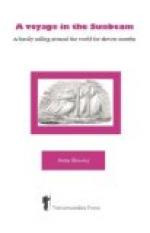One of the late acts of the government has been to declare the Shintoo, as the old religion of the country, to be the only State faith. This is the disestablishment of Buddhism, but it does not imply its suppression. The Buddhist priests complain very much, saying that their temples are not now so popular, and many are being closed. Speculators are buying up their fine bronze bells, and sending them home to be coined into English pennies and halfpennies. Changes in faith present many strange aspects, and this is certainly a curious one.
We strolled about the temple grounds, and ascended the hill to see the famous bell, which is the second biggest in Japan. The immense beam which strikes it was unlashed from the platform for our edification, and the bell sent forth a magnificent sound, pealing over the city and through the woods. At one of the gates there is a curious staircase, leading up to the top, and there, over the gate, is seated a figure of Buddha, surrounded by twelve disciples, all carved in wood and coloured. They are quite worth a scramble up to see.
From Chiosiu we went right across the city to the temple of Nishni Hongangi. On our way we were more than once stopped and turned off the direct road, which was kept by soldiers for the passage of the Mikado to worship at the tombstone of his innumerable ancestors, real or imaginary. Being a spiritual Emperor, he has to be well kept up to his religious duties, and is always being sent off to worship at some shrine or another, in order to maintain his popularity with the people, his Ministers meanwhile managing the affairs of state. Tanjo and Ikawura went off in haste to-day to Tokio, as there are rumours of a rebellion in the south.




